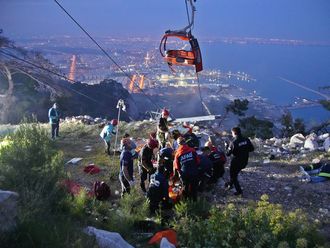Paris: Young drug users risk ending up as “human guinea pigs” for a new wave of sometimes highly toxic recreational drugs, the European Union’s drug monitoring body warned in a report released on Tuesday.
Europe faces a growing drugs problem fed by new, more powerful products, different production techniques and online sales, said the European Monitoring Centre for Drugs and Addiction.
The agency said it had identified more than 560 new psychoactive substances (NPS), most of them synthetic versions of cannabis or of stimulants such as amphetamines or cocaine.
“Young consumers may unwittingly be acting as human guinea pigs for substances for which the potential health risks are largely unknown,” said the report.
One synthetic stimulant had been linked to nearly 200 serious cases of intoxication and more than 100 deaths since 2011.
Some synthetic cannabinoids, sold as legal alternatives to cannabis, had proved highly toxic, with one such drug linked to 13 deaths and 23 non-fatal overdoses across Europe since 2014.
The report also noted a revival in the use of MDMA, better known as ecstasy.
Over the last year, 2.1 million young adults aged between 15 and 24 — 1.7 per cent of that age group — had reported using ecstasy, it said.
“There are also signs that MDMA is no longer a niche or subcultural drug used in dance clubs, but is now being used by a wider range of young people in more mainstream nightlife settings, such as bars and parties,” it added.
New production lines and online sales were feeding the ecstasy boom. Police raids in recent years have shut down major factories in Belgium and the Netherlands.
The agency also reported 6,800 deaths by overdose in 2014, mainly due to heroin or other opioids.
Although that figure was only slightly up on the previous year, it included sharp rises in countries including Britain, Ireland, Lithuania and Sweden.
The reason for the rise in overdoses was unclear, but the increased availability of heroin, high purity and ageing users might have contributed, the report said.
An estimated 1.2 million people were treated for illicit drug use in the European Union in 2014 — 1.5 million including Norway and Turkey.
An analysis of drugs seizures, surveys and wastewater in major cities indicated that cocaine use was higher in western and southern European countries, reflecting ports of entries and trafficking routes.
Amphetamine use was more prominent in northern and eastern Europe, the report added.
While levels of drug injection were falling, the increased injection of stimulants, known as “slamming”, was worrying — particularly among homosexual men, it said.
“These so-called ‘slamming’ practices are associated with high levels of sexual risk-taking behaviours, pointing to the need for increased cooperation and a joined-up response from drug treatment and sexual health services,” said the report.
Cannabis remained the main drug of choice, with 16.6 million young Europeans (aged 15 to 34) using it in the last 12 months.
“For both resin and herbal cannabis, potency levels are high by historical standards and this is worrying, as it may increase the risks of users experiencing both acute and chronic health problems,” it said.
Policymakers had to get to grip with the challenge posed by online sales threat, said the report.
“The supply of drugs through online sources appears to be growing, albeit from a low base, and the potential for expansion of online drug supply appears considerable,” it warned.












